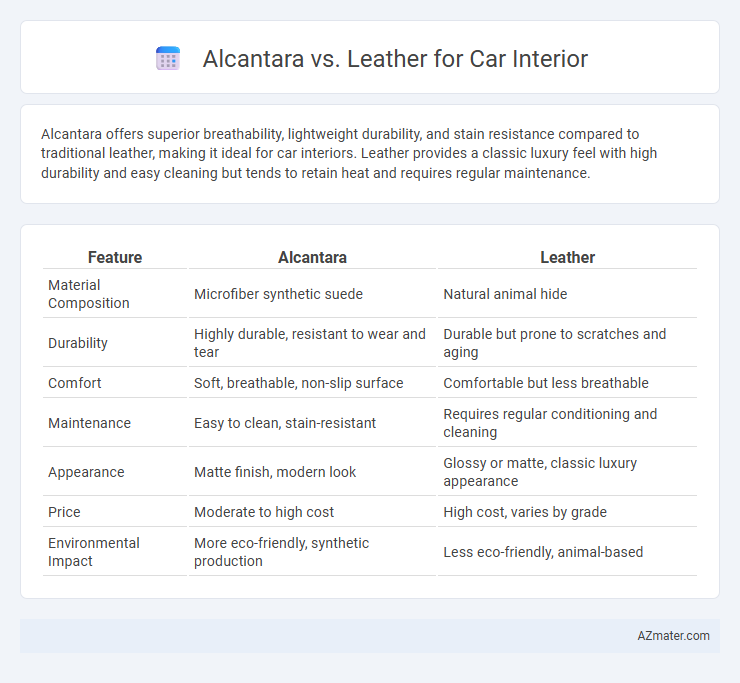Alcantara offers superior breathability, lightweight durability, and stain resistance compared to traditional leather, making it ideal for car interiors. Leather provides a classic luxury feel with high durability and easy cleaning but tends to retain heat and requires regular maintenance.
Table of Comparison
| Feature | Alcantara | Leather |
|---|---|---|
| Material Composition | Microfiber synthetic suede | Natural animal hide |
| Durability | Highly durable, resistant to wear and tear | Durable but prone to scratches and aging |
| Comfort | Soft, breathable, non-slip surface | Comfortable but less breathable |
| Maintenance | Easy to clean, stain-resistant | Requires regular conditioning and cleaning |
| Appearance | Matte finish, modern look | Glossy or matte, classic luxury appearance |
| Price | Moderate to high cost | High cost, varies by grade |
| Environmental Impact | More eco-friendly, synthetic production | Less eco-friendly, animal-based |
Introduction: Alcantara vs Leather in Car Interiors
Alcantara and leather are two popular materials used in car interiors, each offering distinct benefits in terms of comfort, durability, and aesthetics. Alcantara, a synthetic suede-like fabric, excels in breathability and resistance to wear, making it ideal for sporty and luxury vehicles. Leather provides a classic, high-end look with superior aging qualities and is easier to clean, appealing to those seeking a traditional, upscale interior finish.
Material Composition: What Is Alcantara? What Is Leather?
Alcantara is a synthetic material composed of 68% polyester and 32% polyurethane, designed to mimic the texture and appearance of suede with enhanced durability and stain resistance. Leather is a natural material derived from animal hides, primarily cowhide, known for its breathability, aging characteristics, and unique grain patterns. The blend of synthetic fibers in Alcantara offers lightweight flexibility and uniformity, while leather provides a luxurious feel and natural ventilation in car interiors.
Aesthetic Appeal: Looks and Design Versatility
Alcantara offers a modern, luxurious aesthetic with a suede-like texture that enhances the visual sophistication of car interiors, providing a sleek, matte finish that resists glare and complements contemporary design trends. Leather delivers a classic, timeless look characterized by its smooth, polished surface and natural grain patterns, offering rich color depth and a premium feel that appeals to traditional luxury preferences. Alcantara's design versatility allows for greater customization in colors and finishes, while leather maintains durability and ages gracefully, developing a unique patina that adds character over time.
Comfort and Tactile Feel Comparison
Alcantara offers a soft, suede-like texture that enhances comfort by providing a breathable and temperature-neutral surface, reducing discomfort during extreme weather. Leather delivers a smooth, luxurious feel with natural elasticity but can become sticky in heat and cold in low temperatures, affecting tactile comfort. The microfiber composition of Alcantara also provides superior grip, while leather's firmness appeals to those preferring a classic, polished touch in car interiors.
Durability and Wear Resistance
Alcantara offers superior durability and wear resistance compared to traditional leather, especially in high-traffic automotive interiors. Its synthetic microfibers resist stains, fading, and scratches while maintaining flexibility and softness over time. Leather, although durable, tends to crack and lose its finish under prolonged exposure to heat and UV rays, leading to a shorter lifespan in demanding driving conditions.
Maintenance and Cleaning Requirements
Alcantara requires gentle maintenance using a soft brush and mild soap solution to prevent damage, while leather demands regular conditioning to avoid drying and cracking. Stain removal on Alcantara should be done promptly with a damp cloth, whereas leather can tolerate specialized cleaners designed to preserve its texture. Both materials benefit from avoiding harsh chemicals, but Alcantara's suede-like texture is more susceptible to water spots and dirt accumulation compared to leather's naturally resilient surface.
Cost and Affordability: Alcantara vs Leather
Alcantara offers a more affordable alternative to genuine leather while maintaining a luxurious look and feel, making it a cost-effective choice for car interiors. Leather, especially high-quality hides, tends to be more expensive due to its durability and premium status, but may require higher maintenance costs over time. Alcantara's synthetic composition also reduces long-term expenses as it is easier to clean and less prone to wear, enhancing overall affordability.
Environmental Impact and Sustainability
Alcantara car interiors offer a more sustainable option compared to traditional leather, as they are made from a blend of polyester and polyurethane, which requires less water and fewer chemicals during production. Unlike leather, which involves livestock farming contributing significantly to greenhouse gas emissions and deforestation, Alcantara's synthetic composition reduces environmental footprint and promotes resource efficiency. Furthermore, Alcantara is fully recyclable and designed for durability, making it a more eco-friendly choice for automotive interiors aiming to minimize environmental impact.
Performance in Extreme Weather Conditions
Alcantara outperforms leather in extreme weather conditions by maintaining superior breathability and temperature regulation, reducing discomfort from heat in summer and cold in winter. Its synthetic composition resists cracking and fading caused by prolonged sun exposure and fluctuating temperatures better than natural leather. Although leather offers durability, Alcantara's moisture-wicking properties enhance driver comfort and performance under harsh environmental stresses.
Which Is Best for You: Choosing Between Alcantara and Leather
Alcantara offers a luxurious, suede-like texture that provides excellent grip and breathability, making it ideal for sporty car interiors or hot climates. Leather boasts durability, ease of cleaning, and a classic aesthetic, preferred by those seeking a premium, timeless look with effortless maintenance. Choose Alcantara if you value comfort and modern style, or leather for robustness and traditional elegance in your car interior.

Infographic: Alcantara vs Leather for Car Interior
 azmater.com
azmater.com